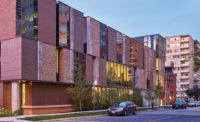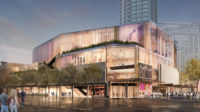Dr. Jiwon Oh passed through the waiting room of the BARLO MS Centre and saw a patient whose appointment at the multiple sclerosis clinic wasn’t for a couple of hours. “I assumed it was a mistake,” the neurologist and head of the facility recalls. “But, no: he told me, ‘I wanted to come early, just to spend some time in the space.’ ”
Health-care environments rarely prompt that sort of reaction. But BARLO—which occupies 30,000 square feet on the two top floors of the 17-story Peter Gilgan Patient Care Tower of St. Michael’s Hospital (recently completed by the a/e firm NORR) —is an exception. The interior’s design, by Hariri Pontarini Architects (HPA), provides a calming atmosphere that evokes a high-end hotel. A refined material palette includes walnut millwork and honed limestone.

White oak millwork and a slatted ceiling of whitewashed pine add to the clinic’s soothing ambience. Photo © Ben Rahn / A-Frame, click to enlarge.
This restrained and coherent design language responds to the experience of patients with multiple sclerosis, a complex disease of the central nervous system. “Their journey in life is hard and unpredictable,” says HPA principal Siamak Hariri about people with MS, “and hospitals can be scary. Here we wanted to provide spaces of comfort and think about all the little things the patients might need.” BARLO brings together clinicians and medical researchers as well as researchers from different disciplines, to provide a single destination for patients who need different kinds of care. MS symptoms vary. They often include vision loss, loss of coordination, and cognitive impairment.
Such constraints shaped HPA’s design for the clinic. The reception desk by the elevator is a curvy hunk of solid surface, friendly to the touch and low in height, so that someone in a wheelchair can see the staff. From there, patients proceed into a two-story atrium enclosed by sinuous white-oak millwork. A stair runs up through a biomorphic opening to the second floor, illuminated from above by an oculus—a skylight that HPA integrated into NORR’s structure.

The two levels are accessible by the deep-treaded low-riser stair. Photo © Ben Rahn / A-Frame
HPA detailed the stair—and many other aspects of the clinic—after extensive consultation with medical staff. This feature has a gentle slope, deep treads, and low risers. This makes it ideal, Hariri says, for patients with balance problems. Bronze handrails on both sides provide support at every step. These decisions make the stair a good venue for rehabilitation work.
The architects have applied a similar rigor both to ordinary spaces, such as clinical exam rooms—created with staff input and full-scale mockups—as well as to specialized ones. Patients meet their doctors in circular consultation rooms, wrapped by curved walnut paneling alternating with glass. Each of these intimate spaces is organized around a wood conference table with custom chairs. “This, the place for conversation,” Hariri says, “creates a sense of warmth and changes the whole feeling for the patients, as well as the doctors.”

1
A sinuous balustrade for the stair underneath a biomorphic skylight (top), as well as semicircular alcoves for infusions (1) give an organic quality to the modernist spaces. Photos © Ben Rahn / A-Frame

2

3
Natural materials prevail, as seen in the walnut-paneled family consultation rooms on the reception floor (2 & 3). Alternating with special glazing, the enclosures provide privacy and light to these intimate spaces. Photos © Ben Rahn / A-Frame
The architects have heightened this sense of occasion with details and materials not often seen in a health-care setting. Throughout, the ceilings are clad with slats of whitewashed pine, which obscure mechanical equipment while adding visual warmth and diffusing sound. Although HPA has refined the use of wood in its residential architecture, this is not a standard material in a hospital context, where infection control is paramount and where surfaces are frequently treated with harsh cleaning agents. The design team met with the hospital’s housekeeping staff and infection-control experts to settle on finishes that were hardy enough to meet those standards.
Hariri had previous experience with challenging health-care projects, such as Casey House, a freestanding HIV/AIDS hospital in Toronto that also demonstrates design sensitivity. And yet such rigorous pursuit of beauty is rare in Canadian hospitals, which are predominantly funded by the government. At BARLO, philanthropy opened the doors to architectural research and development, as well as subsidizing additional building costs. The center is named for the Barford and Love families, who each donated $8 million toward the $33.5 million project. Jon Love, a prominent Toronto real-estate executive, was “a force” behind the project, Hariri says, insisting on a high quality of materials, finishes, and spaces at every turn.
Approximately one-quarter of the center’s floor area is reserved for researchers, including spaces such as conventional cubicles and a large kitchen in which, according to the staff, collegial lunches have become a trend. Dr. Oh says the co-location of research and treatment has greatly helped increase communication between these two areas. But the quality of the architecture also “hugely improves the quality of care,” she says. “It is one of those soft things that is hard to quantify, but it absolutely makes a difference.”
Click drawing to enlarge

Credits
Architect:
Hariri Pontarini Architects — Siamak Hariri, design lead; Doron Meinhard, Greg Adams, Miren Etxezarreta-Aranburu, Andrew Manson, Maryam Malekzadeh, Steve Kang, Byungju Choi, Jimmy Farington, Madi Jantzi, Ramin Movasagh, Liliana Guerrero, Rajesh Valinjkar, team
Engineers:
Thornton Tomasetti (structural);
HH Angus & Associates (m/e)
Consultants:
Jensen Hughes (code); Total Opening Consultants (hardware)
General Contractor:
EllisDon Corporation
Client:
St. Michael’s Hospital
Owner:
Unity Health Toronto
Size:
30,000 square feet
Project Cost:
$33.5 million
Completion Date:
October 2021
Sources
Glass:
Central Canadian Glass
Special Glass:
Redspire Architectural Glass
Skylights:
Alumicor
Acoustical Ceilings:
CertainTeed
Paints and Stains:
Sherwin-Williams
Solid Surfacing:
Corian
Plastic Laminate:
Formica, Pionite
Wall Coverings:
Metro Wallcoverings; National Solutions/Urban Forest
Locksets and Exit Devices:
Stanley







